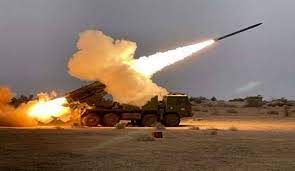15 Apr 2022 Advanced Pinaka Mk-I Rocket System (EPRS)

Advanced Pinaka Mk-I Rocket System (EPRS) – Today Current Affairs
- The Advanced Pinaka Mk-I Rocket System (EPRS) was successfully test fired at the Pokhran range in Rajasthan.
- Area Denial Munition (ADM) was also successfully tested as part of the same set of trials.
- The tests also validated the performance of a variety of warheads and fuses that can be used in the Pinaka rocket system.
- ADM is a category of ammunition that is used to prevent the enemy from occupying or passing through a particular area.
Today Current Affairs
What is EPRS?
- EPRS is an improved version of the Pinaka variant which is in service of the Indian Army for the past decade.
- Designed and developed by Pune based DRDO (Defence Research and Development Organisation) laboratories- Armament Research and Development Establishment (ARDE) and High Energy Materials Research Laboratory (HEMRL). The Hindu Analysis
- Upgrades include advanced technologies that increase the range to meet the evolving needs of the battlefield.
- While the range of Mark-1 is 38 km. The upgraded version of the Mark-1, which was tested in the last fortnight, has a range of 45 km with some major additional features.
- The new incarnation of the Pinaka represents one of the few examples of the development process being developed with an indigenous Indian weapon system.
Pinaka Missile : The Hindu Analysis
- Pinaka Rocket System is a multi-barrel rocket system, named after the bow of Lord Shiva.
- It has been developed by the Pune-based Armament Research and Development Establishment (ARDE) and the High Energy Materials Research Laboratory (HEMRL). Today Current Affairs
- The development of the ‘Pinaka’ multi-barrel rocket system was initiated by the Defense Research and Development Organization (DRDO) in the late 1980s. It was developed as an alternative to Russia’s ‘Multi Barrel Rocket Launcher’ system (also known as ‘Grad’). The Hindu Analysis
- After the successful trials of Pinaka Mark-1 in the late 1990s, it was successfully used on the battlefield for the first time during the Kargil War of 1999. This was followed by several regiments of the system in the 2000s.
Features : The Hindu Analysis
- As a key strategy in long-range artillery combat, launch vehicles typically have to ‘shoot and scoot’ detectable due to its back blast to ensure that they themselves don’t be a target.
- It can fire 12 rockets in a duration of 44 seconds.
- A battery of the Pinaka system consists of six launch vehicles, including a loader system, radar and links with network-based systems, and a command post. One battery 1 km. area can be neutralized.
Version : The Hindu Analysis
- The Defense Research and Development Organization has also developed and successfully test-fired the Mk-II and Guided variants of the Pinaka, which have a range of about 60 km, while the Guided Pinaka system has a range of 75 km and also has an integrated navigation, control and guidance system.
- The navigation system of the Guided Pinaka missile is also aided by the Indian Regional Navigation Satellite System (IRNSS).


No Comments